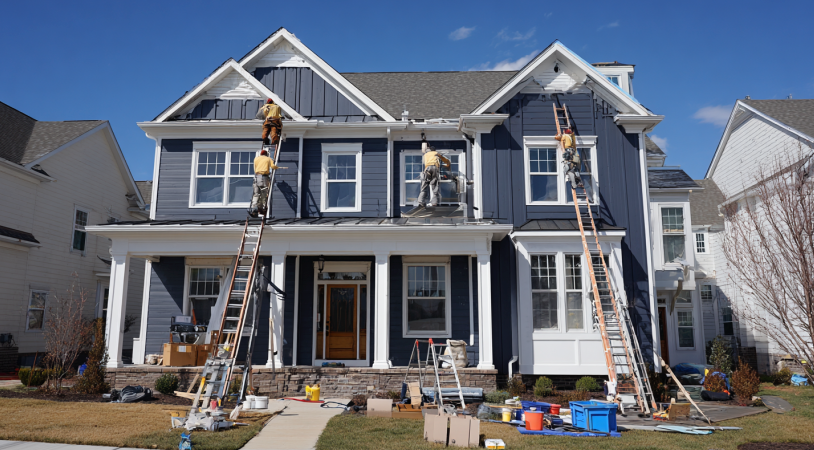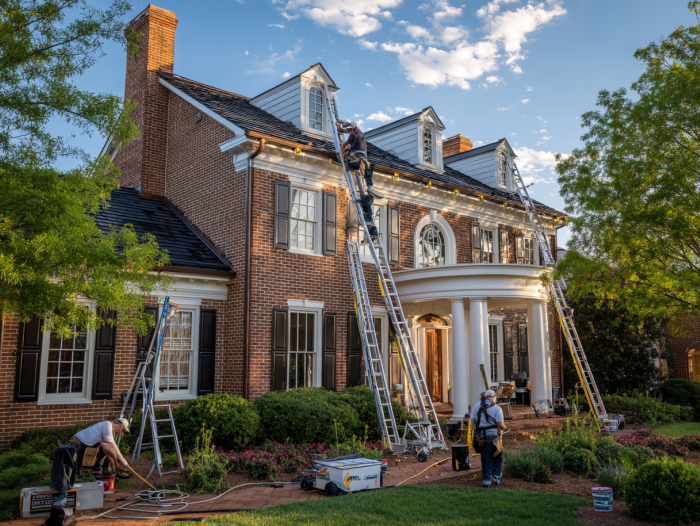As the cold months approach, roofing companies everywhere are hustling to finish their final projects before snow and freezing rain set in. But while most contractors focus solely on roofs, the smartest ones use this time to expand.
Many roofers already install gutters or siding, yet few take the next step, pairing or bundling these services strategically to create more value for homeowners and higher profits for themselves. When you offer homeowners complete exterior solutions instead of isolated services, you not only protect their homes more effectively but also increase your revenue per project and position your company as the go-to exterior systems expert.
The U.S. roofing industry continues to expand, with total market value projected to reach over $31 billion by 2025. Yet as competition grows, contractors who diversify into complementary services like gutters and siding will capture a larger share of that growth.
Bundling services like rain gutter installation and vinyl siding installation adds natural synergy to every job. The result? Better protection for the homeowner, greater efficiency for your team, and a stronger reputation for your business.
Key Takeaways:
- How to package roofing, siding, and gutters for higher profits and happier customers
- What to consider before offering bundled upgrades
- Systems and workflows that make multi-service sales simple and consistent
Need expert help creating bundled service campaigns that convert? JobNimbus Marketing can help your roofing business grow smarter and faster.
What Revenue Opportunities Are Many Roofing Contractors Overlooking?
Most roofing contractors overlook how offering gutters and siding with roofing can protect homes and unlock new revenue streams.
Many roofing contractors already offer gutter or siding services, but few truly integrate them into a single, cohesive sales strategy. Most present these add-ons separately, or only when a homeowner specifically asks about them. This fragmented approach leaves significant money on the table.
Roofing, siding, and gutters work together as one system. The roof directs water to the gutters, which protect the siding and foundation from damage. When these services are sold individually instead of as part of a bundle, homeowners may not see the bigger picture, and contractors miss the chance to increase both project value and client satisfaction.
By bundling these services in your proposals, you make it easier for homeowners to understand how the entire system protects their property. Instead of having to make multiple decisions with multiple contractors, they get one streamlined solution. That convenience translates into higher conversion rates, larger average tickets, and a better overall customer experience.
Every roof you replace sits above siding and connects directly to a drainage system. If those supporting systems fail, the roof’s integrity suffers, as does your reputation. Expanding your service menu to include siding and gutter installation as bundled upgrades transforms your company into a true full-solution provider for home exteriors.
This expansion allows every roof estimate to become an opportunity for a complete exterior project. The added services not only raise your average job value but also strengthen your reputation as a trusted expert in total home protection.
Why Do Gutters Matter So Much for Roofing Projects?
Many roofers install gutters but don’t always emphasize their importance as part of the roofing system. Gutters determine where water goes after it leaves the shingles. If they’re poorly installed or neglected, even a brand-new roof can develop leaks, ice dams, and fascia damage.
By bundling rain gutter installation with roof replacements, you demonstrate a commitment to complete protection. Instead of offering gutters as a separate option, show homeowners how proper drainage keeps their roof performing better for years.
This simple shift from “extra service” to “essential upgrade” makes the upsell feel natural. It prevents future issues for the homeowner and reduces warranty claims for your company, all while increasing your average project value.
Why Should Roofers Offer and Bundle Siding Services with Roofing?
Siding is another area where many contractors miss out on revenue. While some roofers offer siding work, they rarely promote it alongside roofing in a unified package. That separation keeps customers from seeing the full value of upgrading both at once.
Siding protects the walls from moisture, improves insulation, and ties directly into roof flashing and trim. When you include siding in your roof proposals, you help homeowners create a fully integrated exterior that looks better, performs better, and lasts longer.
By bundling roofing and siding services, you also make it easier for customers to manage their projects. Instead of hiring multiple contractors, they can rely on one trusted partner for the entire job, a convenience that often leads to faster sales and higher closing rates.
Why Does Diversifying Into Gutters and Siding Boost Lead Generation and SEO?
Expanding into gutters and siding helps roofers attract a broader and more consistent flow of leads online. While most roofing companies compete for the same “roof replacement” keywords, far fewer optimize for terms like “install rain gutters” or “vinyl siding installation.” That leaves a major gap in local search visibility that smart contractors can fill.
If you already provide these services but they’re buried on your website or not presented as bundled solutions, you’re missing valuable organic search traffic. This is where search engine optimization (SEO) becomes a strategic advantage. By optimizing your website content, service pages, and metadata to include keywords for roofing, siding, and gutter installation, you expand your reach to multiple homeowner needs and search intents.
Roofing companies that expand their service pages and optimize for multiple local keywords can see up to 126% more organic traffic. That’s the power of pairing diversification with strong search engine optimization — it multiplies your visibility and your opportunities.
Effective SEO ensures that when homeowners search for any part of an exterior system — roofing, gutters, or siding — your business appears as the complete, trusted solution. The more relevant, keyword-rich content you publish around these connected services, the more search engines recognize your authority, helping you rank higher and attract better-qualified leads.
When you combine smart SEO with a diversified service strategy, you not only capture more traffic but also convert it more efficiently. Many homeowners who first find you for gutter or siding needs will ultimately become roofing customers too, allowing your digital presence to deliver exponential returns.
How Can Roofing Contractors Successfully Upsell Gutters and Siding?
Roofing contractors can increase sales by showing homeowners how bundled exterior services create better protection and greater long-term value.
Most roofers who offer gutters or siding mention them at the end of a roofing quote. The secret to success is flipping that order, and introducing these services as part of the complete home protection package from the start.
When homeowners see gutters and siding presented as complementary, not optional, they understand the logic immediately. You’re not selling extras; you’re helping them complete the system.
How Does the “Complete Protection” Approach Build Trust and Drive Sales?
Homeowners don’t want to feel like they’re being upsold. They want confidence that their home will be safe and efficient for years. By presenting roofing, siding, and gutters as an integrated system, you turn what could feel like an “upsell” into an act of protection.
“We’re not just replacing your roof; we’re building a system that directs water safely, seals your walls, and keeps your home protected year-round.”
This approach reframes your role from vendor to advisor. It builds deeper trust and makes homeowners more likely to move forward with larger, bundled projects.
Why Should Roofing Companies Offer Tiered Packages for Exterior Services?
Tiered packages make bundling effortless. Many contractors already have separate pricing for gutters and siding, but few package them into easy-to-understand tiers that simplify decision-making.
Try structuring your offerings like this:
- Good: Roof replacement only
- Better: Roof and gutter installation
- Best: Roof, gutters, and siding upgrade
This approach helps customers visualize the advantages of choosing a more complete package. Homeowners naturally gravitate toward the “Better” or “Best” options because they feel they’re getting full value for their investment.
How Can Visual Presentations and Demonstrations Boost Sales?
Most homeowners aren’t experts in exterior systems, which makes it hard for them to understand how gutters, siding, and roofing work together. That’s why visuals are among the most effective tools in your sales process.
Photos, diagrams, and digital renderings make complex ideas clear and tangible. When homeowners can see how a roof connects to gutters and how siding seals the home’s exterior, they grasp the full value of your bundled services. This clarity makes bundling feel like the logical solution, not a sales tactic.
Examples of Effective Visual Tools
Visual Type | Purpose | Best Used For |
Before-and-after photos | Show transformation and value of full exterior upgrades | Sales presentations, brochures, or proposals |
Diagrams or 3D renderings | Explain how roofing, gutters, and siding work together | On-site inspections or digital quotes |
Short video clips | Demonstrate water flow, flashing connections, and installation process | Website, social media, or consultation |
Drone or time-lapse footage | Showcase workmanship, scale, and attention to detail | Portfolio, marketing campaigns, or follow-ups |
Color and design mockups | Help homeowners visualize curb appeal improvements | Pre-sale consultations or design discussions |
By using visuals like these, you take abstract concepts and make them easy to understand, helping homeowners visualize how their investment pays off.
Benefits of Using Visual Demonstrations
- Simplifies complex concepts: Shows how different exterior components connect and function as one system.
- Builds trust and transparency: Homeowners can see your work quality and understand exactly what they’re paying for.
- Creates emotional engagement: Visuals help clients imagine their home looking better and lasting longer.
- Reinforces bundling logic: Demonstrates that roofing, gutters, and siding aren’t separate purchases but parts of one cohesive protection plan.
- Improves close rates: Seeing real results motivates faster decisions and builds confidence in your recommendations.
End each presentation by linking visuals back to tangible results. For example, show how upgraded gutters prevent ice dams, how new siding improves energy efficiency, or how the entire system enhances curb appeal. When homeowners can see both the visual and functional benefits, they view your bundled services as a smart, long-term investment rather than an upsell.
How Should Roofing Contractors Offer Discounts or Financing to Close More Sales?
Bundled projects can initially seem expensive to homeowners, even when they understand the value. Offering clear financing options and small, well-structured package discounts helps bridge that gap and turns hesitation into confidence.
Start by presenting a modest percentage off — such as 5 to 10 percent — when homeowners combine roofing, siding, and gutter upgrades in one project. You can also roll all services into a single financing plan with one monthly payment. This approach keeps your pricing simple and easy to digest, while emphasizing long-term affordability.
Consider creating tiered bundles with built-in savings. For example:
- Basic Package: Roof replacement only
- Plus Package: Roof and gutter installation (5% savings)
- Complete Package: Roof, siding, and gutters (10% savings + extended warranty)
This structure gives homeowners clear, side-by-side comparisons and shows them how bundling saves money without compromising quality.
For many customers, the idea of “one payment, one contractor, one timeline” is more appealing than any single discount. It reduces decision fatigue, builds trust, and keeps your project pipeline full year-round. The easier you make it to say yes, the more often homeowners will move forward with your bundled exterior solutions.
Why Is Team Training Crucial for Consistent Upselling?
Many roofing teams notice gutter or siding issues during inspections but hesitate to mention them, unsure of how to bring them up naturally. Proper training turns those missed observations into confident conversations that add value for both the homeowner and your business.
Start by teaching your team to view every roof inspection as a total home protection assessment, not just a roofing evaluation. When they understand how to connect roof performance with gutters, siding, and drainage, they can educate homeowners about the importance of addressing all these elements together.
Provide every salesperson and crew leader with clear talking points, photo examples, and short scripts that explain common issues in plain language. For instance, instead of saying, “You should replace these gutters,” they could say, “These gutters aren’t draining correctly, which could shorten the life of your new roof. We can solve that while we’re here.”
The goal isn’t to push extra work, it’s to inform. Homeowners respect knowledgeable professionals who take the time to explain how systems interact. When your entire team understands how to communicate that value consistently, upselling becomes effortless, customer satisfaction improves, and your close rate rises naturally.
How Should Contractors Handle Objections Without Sounding Pushy?
Homeowners often hesitate not because they don’t care, but because they don’t fully understand how roofing, gutters, and siding work together as one system. Objections are a natural part of the process, and addressing them calmly and factually can turn doubt into trust.
When homeowners raise concerns, focus on listening first, then educate. Here’s how to respond without sounding like you’re selling:
- Cost: Explain that bundling is more economical than scheduling separate jobs later. It saves on labor, materials, and future repair costs while providing a more complete solution now.
- Timing: Emphasize convenience and efficiency. Combining the work now means fewer disruptions, one project timeline, and a home that’s fully protected before the next season.
- Necessity: Use real examples or photos to show how neglecting one system can compromise another, such as clogged gutters leading to roof leaks or poor siding drainage causing foundation issues.
End each conversation by reinforcing your role as a trusted advisor: you’re not trying to sell more; you’re trying to help them prevent costly problems. When you focus on protection, longevity, and peace of mind, the discussion naturally shifts from cost to value, and the decision to move forward feels effortless.
What Is the Business Impact of Mastering Bundled Upsells?
Roofers who master the art of bundling create steady, predictable growth instead of relying solely on the next lead or seasonal surge. By consistently offering gutters and siding alongside roofing, you increase your average revenue per customer while improving overall project satisfaction and long-term loyalty.
Bundled services are more efficient to schedule, easier to market, and significantly more profitable to complete. Each project produces more value with the same amount of effort, which stabilizes cash flow and keeps crews working consistently throughout the year.
Over time, this approach builds a strong brand reputation centered on quality, convenience, and expertise, the exact combination homeowners look for when choosing a contractor. Mastering bundled upsells isn’t just about closing more deals; it’s about creating a scalable, dependable business model that grows with every project you complete.
What Should Contractors Consider Before Expanding Into Gutters or Siding?
Contractors should assess materials, climate, and installation methods carefully to ensure successful service bundling.
When you expand beyond roofing, focus on products and materials that complement your core services and align with your region’s weather conditions. For example, heavy snowfall may require stronger gutter brackets or more durable siding materials.
Present these additions as part of a unified exterior system, not separate projects. When homeowners see how each element — the roof, gutters, and siding — works together to protect their home, it becomes clear that addressing everything at once is the most efficient, cost-effective, and lasting solution.
Which Materials Deliver the Best Long-Term Value for Different Climates?
Material performance should always guide your recommendations. The right combination of roofing, gutter, and siding materials ensures every system works together efficiently and stands up to your local climate.
Aluminum gutters remain the most popular choice for their affordability, corrosion resistance, and ease of installation, while copper gutters offer superior longevity and timeless curb appeal for homeowners seeking a high-end look. For siding, vinyl provides an excellent balance of cost and energy efficiency in moderate climates, while fiber cement is the top performer in regions with heavy moisture, strong winds, or temperature extremes.
Bundling these materials in smart combinations helps you present tailored solutions that make sense for each homeowner’s needs. When customers see that you’ve considered both performance and appearance, they perceive your recommendation as thoughtful, not sales-driven.
Climate / Condition | Ideal Roofing Material | Ideal Gutter Type | Ideal Siding Material | Why This Works |
Cold / Snowy Regions | Asphalt or metal roofing | Steel or aluminum gutters | Fiber cement or insulated vinyl siding | Handles freeze-thaw cycles, resists ice dam damage, and improves insulation. |
Hot / Sunny Climates | Metal or tile roofing | Aluminum gutters (light-colored finish) | Vinyl or fiber cement siding (UV-resistant) | Reflects heat, reduces fading, and keeps cooling costs lower. |
Rainy / Coastal Areas | Architectural shingles or metal roofing | Copper or coated aluminum gutters | Fiber cement or composite siding | Resists salt, moisture, and corrosion; offers superior drainage and durability. |
Windy / Storm-Prone Zones | Metal roofing with secure fasteners | Heavy-gauge aluminum or seamless gutters | Fiber cement or engineered wood siding | Withstands wind uplift and protects from flying debris and moisture. |
Mild / Temperate Regions | Asphalt shingles | Aluminum or vinyl gutters | Standard vinyl siding | Affordable, easy to maintain, and provides good protection for balanced climates. |
When you present these pairings visually, homeowners immediately understand that your recommendation isn’t random, it’s designed for their exact environment.
Explaining these options as part of a bundled proposal also allows you to show how each material supports the others. The roof sheds water effectively, gutters control flow and protect siding, and the siding insulates and seals the home. It’s one complete system, customized for long-term protection and performance.
When you take this holistic approach, you elevate your company from a single-service contractor to a trusted exterior solutions expert, the kind of professional homeowners are willing to invest more in.
How Do Aesthetics and Design Affect Homeowner Decisions?
Homeowners may start the conversation focused on function, such as leaks, damage, or efficiency, but they often make their final decision based on how the finished project will look. Bundled exterior projects give them the perfect opportunity to reimagine their home’s entire appearance while improving performance at the same time.
Use color-matching software, digital renderings, and material samples to show how each element — the roof, gutters, and siding — works together visually. When homeowners can see how textures, tones, and finishes align, they begin to think in terms of transformation rather than repair.
If possible, present multiple design options. For example, show how a darker roof with lighter gutters and neutral siding changes the home’s character, or how matching trim and gutter colors can make the exterior look more cohesive. The more they can visualize these combinations, the easier it is to justify upgrading everything at once.
By positioning bundled upgrades as both a performance improvement and a design enhancement, you appeal to both logic and emotion, two powerful motivators that help homeowners feel confident investing in a complete exterior renovation.
Why Is Proper Drainage and Installation Planning Essential?
Proper drainage and installation planning are critical to the success of every roofing, gutter, and siding project. Each system depends on the other to move water safely away from the home and prevent long-term damage.
Before quoting, take time to inspect roof slopes, fascia boards, soffits, and downspout locations. Look for signs of improper water flow, fascia rot, or gutter pitch issues that could undermine the performance of a new roof or siding installation. Documenting these details during your assessment shows professionalism and helps you create a proposal based on facts rather than assumptions.
When homeowners see that you’ve mapped out how water travels from the roofline down through the gutter system and away from the siding and foundation, it builds immediate confidence. It demonstrates that bundling these services isn’t about selling more, it’s about designing a home exterior that functions as one cohesive, long-lasting system.
By emphasizing planning and precision, you show clients that your goal is protection, not just profit, and that distinction is what sets true professionals apart.
What Role Do Warranties and Local Codes Play in These Projects?
Warranties and code compliance are essential to the success of any bundled exterior project. When managed correctly, they protect both you and the homeowner while simplifying maintenance and future service needs.
Always confirm that the roofing, gutter, and siding materials you install are compatible under their respective manufacturer warranties. Using products from approved combinations prevents warranty voids and ensures long-term coverage for the homeowner. In addition, review local building codes related to drainage, materials, and structural fastening before work begins to avoid costly rework or inspection delays.
Attention to these details builds homeowner confidence and reinforces your professionalism. It shows that your business prioritizes compliance, accountability, and lasting quality, all qualities that set apart reliable contractors from those who cut corners.
How Should a Roofing, Gutters, and Siding Project be Scheduled?
Efficient scheduling is essential for delivering high-quality bundled projects and maintaining smooth operations. When roofing, gutters, and siding are installed in the proper sequence, you prevent damage, reduce overlap, and ensure every system performs as intended.
Follow this proven order to complete each phase efficiently and professionally:
- Install the roof first – Begin with the roofing system to create a watertight foundation and ensure proper flashing and edge protection before any other work begins.
- Add gutters second – Once the roof is secure, install the gutters to establish correct drainage paths. This prevents runoff from damaging newly installed siding and prepares the structure for final finishing.
- Finish with siding and trim – Complete the siding installation last to protect walls, close gaps, and tie the entire exterior together visually and structurally.
Following this sequence minimizes rework, avoids conflicts between crews, and ensures the finished project looks cohesive and professional.
Clear communication is just as important as timing. Let homeowners know what to expect at each stage and how this process minimizes disruption to their daily routines. Transparent scheduling builds trust and helps clients appreciate the convenience of working with one contractor for their full exterior project.
When you manage sequencing and communication effectively, your crews work more efficiently, your clients feel informed, and your bundled projects run smoothly from start to finish. That level of organization saves time, reduces costs, and reinforces your reputation as a dependable, detail-oriented professional.
What Tools and Systems Help Roofing Companies Manage Multiple Services?
Roofing companies can expand successfully by using digital tools, efficient workflows, and clear communication to manage bundled projects.
Adding new services like gutters and siding can feel overwhelming without the right tools and systems in place. Managing multiple crews, materials, and timelines requires organization and clarity at every step. The good news is that modern technology makes it easy to scale your offerings while keeping operations simple and efficient.
Digital tools and streamlined workflows help you:
- Track leads and estimates for roofing, siding, and gutter projects in one place
- Schedule multiple crews without overlap or downtime
- Maintain real-time communication between office staff and field teams
- Provide accurate, transparent updates to homeowners throughout the project
A reliable project management or trusted roofing CRM ensures nothing slips through the cracks. With these systems in place, you can deliver consistent quality across all services, reduce errors, and build a reputation for organization and professionalism.
Using tools that integrate with estimating software, accounting systems, and customer portals allows your business to operate as one connected unit. When your processes are smooth and predictable, homeowners notice, and that often leads to better reviews, repeat work, and more referrals.
The goal isn’t to complicate your business but to simplify it. By managing roofing, siding, and gutter projects within a single, unified workflow, you free up time for your team to focus on service quality, customer communication, and continued growth.
What Digital Tools Support Multi-Service Sales and Management?
Digital tools are the backbone of running a modern roofing company, especially when managing multiple services like roofing, gutters, and siding. The right software keeps everything organized, improves communication, and helps you deliver a seamless experience from the first estimate to the final walkthrough.
Look for digital tools that make it easy to:
- Manage leads and customer information with a CRM that tracks every interaction, estimate, and follow-up across services.
- Build combined proposals for roofing, siding, and gutter work using estimating software that allows “good, better, best” options and automatic material pricing updates.
- Offer financing and payment options directly within your proposal to help homeowners afford bundled projects more easily.
- Document projects on-site using mobile inspection tools to take photos, add notes, and share updates instantly between teams.
- Automate communication with homeowners using email and text updates for scheduling, progress reports, and payment reminders.
Platforms like JobNimbus, AccuLynx, and Buildertrend allow contractors to manage all of this within one integrated system. These tools make it possible to handle multiple services under a single project file, which reduces confusion, eliminates data duplication, and streamlines billing.
When your digital systems are aligned, you can confidently sell bundled packages knowing that scheduling, communication, and documentation will stay consistent. Homeowners appreciate the organization and transparency, and your team saves time that can be reinvested in growth and customer service.
Ultimately, digital tools are more than conveniences; they’re growth enablers. They allow you to scale your offerings, maintain control over every project, and present your business as a professional, trustworthy partner capable of handling all of a homeowner’s exterior needs.
Which Field Tools Improve Quality and Crew Efficiency?
Having the right field tools is just as important as using good software. Quality equipment directly impacts safety, precision, and how homeowners perceive your professionalism. When expanding into bundled services like roofing, siding, and gutters, investing in reliable tools ensures your team can deliver consistent, high-quality work every time.
Here are the essential field tools and equipment that help improve both performance and presentation:
- Seamless gutter machines: Allow you to fabricate custom gutters on-site, reducing waste and ensuring a perfect fit for every home.
- Laser levels and slope-measurement tools: Guarantee accurate gutter pitch and siding alignment, preventing drainage and appearance issues.
- Moisture meters and inspection tools: Help identify water damage or trapped moisture behind siding or roofing materials before it becomes a problem.
- Safety gear and scaffolding systems: Protect your team while maintaining a professional appearance on-site. Properly equipped crews instill homeowner confidence.
- High-quality power tools and trim cutters: Improve efficiency and precision, resulting in clean, attractive finishes on every project.
- Clean, organized work vehicles: Act as rolling advertisements for your business and reinforce your company’s reputation for reliability.
Well-maintained equipment not only improves your crew’s productivity but also creates a visible difference that homeowners notice. A tidy, well-equipped team conveys competence and professionalism before the first nail is driven.
Encourage your crews to treat their tools and equipment as part of your brand image. When your team shows up with the right tools and works efficiently, it reinforces your reputation as a contractor who values safety, quality, and attention to detail, the same values that justify bundled service investments.
Why Should Roofing Contractors Standardize Workflows for All Services?
Standardized workflows are the foundation of consistent quality, efficiency, and customer satisfaction. When every team member follows the same clear process for roofing, gutters, and siding, projects stay organized, timelines stay predictable, and communication remains seamless.
Without a standardized system, even small projects can become complicated; crews overlap, materials are delayed, and customers get frustrated. A structured approach prevents these issues and helps you deliver a repeatable, high-quality experience across every bundled service.
Here’s a simple, proven workflow you can adapt for your own business:
- Inspect and document all exterior systems.
Begin with a full property evaluation that includes the roof, gutters, siding, fascia, and drainage paths. Take detailed notes and photos to support your recommendations. - Build a comprehensive, bundled estimate.
Present one clear proposal that includes roofing, siding, and gutter options together. Show the benefits and pricing differences between individual and bundled services. - Review visuals and financing options.
Use renderings, material samples, and digital tools to help homeowners visualize the result. Discuss financing or payment plans to make the investment more accessible. - Schedule projects in logical sequence.
Coordinate crews efficiently: roof first, gutters second, siding last. Confirm dates, communicate expectations, and minimize disruptions to the homeowner. - Perform a final walkthrough and gather feedback.
Inspect every element with the homeowner. Demonstrate proper function, review warranties, and request a review or referral while satisfaction is highest.
By using a repeatable process like this, you simplify operations for your team and create a consistent experience that customers come to rely on. It also makes training new employees easier, improves accountability, and provides a structure that supports scaling your business.
Standardized workflows communicate reliability; both internally and externally. Homeowners see your professionalism in how you manage each step, which builds trust and increases the likelihood of repeat business and referrals.
Why Should Roofing Contractors Expand Into Gutters and Siding?
Expanding into gutters and siding helps roofing contractors increase profits, serve clients better, and stand out in competitive markets.
Homeowners today prefer convenience and trust over juggling multiple contractors, and offering bundled exterior services delivers both.
By handling all major exterior systems under one roof, you position your company as a complete home protection partner rather than a single-service provider. This makes your business more valuable to customers and harder for competitors to replace.
Bundled services also improve your operational efficiency. Crews can complete multiple tasks while on-site, saving travel time and maximizing productivity. Your marketing becomes more effective because you can promote comprehensive solutions instead of isolated services, and every lead has greater potential for revenue.
Here’s what makes this strategy so powerful:
- Higher profitability: Bundled projects increase average revenue per job without needing more leads.
- Simplified scheduling: Coordinating services in one project reduces downtime and overlap.
- Improved customer satisfaction: Homeowners get consistent quality, communication, and warranties from one trusted contractor.
- Stronger brand positioning: A full-service exterior contractor stands out in a crowded roofing market.
When you bundle services, you’re not just selling more — you’re helping homeowners protect their biggest investment through a cohesive, long-term solution. That kind of trust turns first-time customers into repeat clients and brand advocates.
To recap:
- Bundling gutters and siding with roofing increases both efficiency and customer value.
- Coordinated systems deliver better performance and aesthetics.
- Clear communication and reliable workflows create trust and repeat business.
Expanding your services transforms your business from seasonal and project-based to stable and scalable. By thinking beyond the roofline, you open the door to consistent growth, greater client loyalty, and stronger profit margins all year long.
Want to grow your roofing business through smart service expansion? Schedule your free strategy session with JobNimbus Marketing to learn how to attract more clients, close higher-value projects, and build a reputation that lasts.
FAQs About Upselling Siding and Rain Gutter Installation
How long does a typical rain gutter installation take?
Most homes can be completed in one to two days, depending on the size of the home, number of downspouts, and complexity of the layout. Larger or custom systems may take longer to ensure proper alignment, sealing, and drainage performance.
Is vinyl siding installation suitable for cold climates?
Yes. When installed with moisture barriers and insulation, vinyl siding performs well in cold climates. It resists cracking, fading, and warping during freeze-thaw cycles, helping to keep interiors warmer and energy bills lower through winter.
How much more does it cost to bundle gutters and siding with a roof?
Bundled projects typically increase the total cost by 15 to 40 percent, depending on materials and design preferences. However, combining the work saves money overall by reducing labor duplication, improving efficiency, and offering a unified warranty.
How should roofing contractors price installing rain gutters?
Price by linear foot, factoring in the material, pitch, labor time, and any accessories such as gutter guards or heated cables. Providing a detailed estimate with clear breakdowns builds trust and helps homeowners understand the value behind the cost.
Should contractors subcontract gutter or siding work?
If you have skilled crews and capacity, keeping the work in-house gives you greater control, quality consistency, and profit retention. Subcontracting can still be effective during peak






